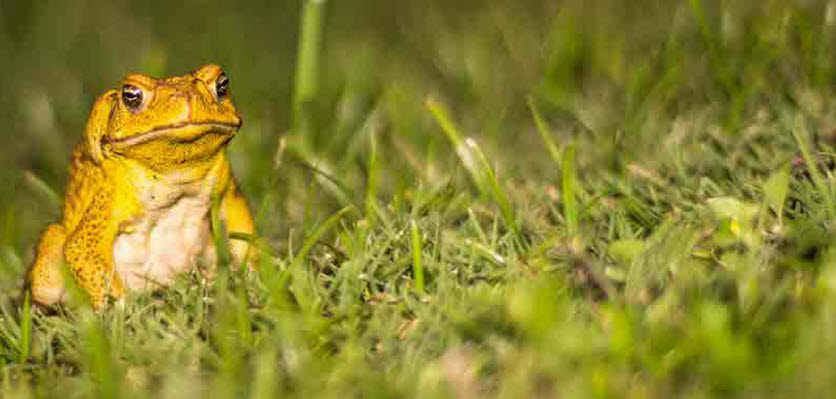
Since their introduction into Queensland in the 1930s, cane toads have gradually made their way across northern Australia. In recent years they’ve even reached the Kimberley region in northern Western Australia. Cane toads have proven to be an extremely adaptive invasive species and have been able to survive and thrive in a range of environments which were previously thought inhospitable for the toad–such as harsh dry areas–by making use of any available source of moisture from man-made dams to cowpats.
The spread of the toads can also be seen as an evolutionary success story in that the toads found moving west across Australia have also evolved to be quite different to their original native variety and have much longer legs, allowing them to travel greater distances. Not only have the toads physically adapted on their move across Australia but their behaviour has also changed.
Cane toads are considered a nocturnal species and will hide away during the day and come out at night to feed and mate. Researchers had previously observed the toads in hot and dry areas being active during the day where they would move into dams and waterways to keep cool, but would still display normal nocturnal behaviours. A new paper recently published in Scientific Reports has highlighted that in the right environmental conditions some populations of cane toads have shifted to a strictly diurnal lifestyle which is a phenomenon known as ‘phase shift’.
Environmental biologist, Dr Simon Clulow, was one of the researchers involved in the study and has been assessing the impacts the toads have had on native wildlife over the past 10 years. Dr Clulow discussed this significant finding with ABC News and said that while he ventured into some of the Kimberley’s deep and rocky gorges, he found cane toads which were strictly active during the day. The diurnal cane toads were only found in areas which were shaded from the sun and provided cool and damp environments throughout the day, while a more exposed section of gorges contained mostly nocturnal toads.
There are only a few other known examples of nocturnal animals becoming strictly diurnal and at this stage it is unclear to Dr Clulow and his team as to why the toads have made the switch, but they hypothesise it may be due to a more abundant food source being present during the day. This adaptability is just another weapon in the toad’s impressive arsenal as they continue their march across Australia.
Reference:
- Doody JS, McHenry CR, Rhind D et al. Novel habitat causes a shift to diurnal activity in a nocturnal species. Sci Rep 2019; 9:230. https://doi.org/10.1038/s41598-01836384-2
This article appeared in the March 2019 issue of the Australian Veterinary Journal
